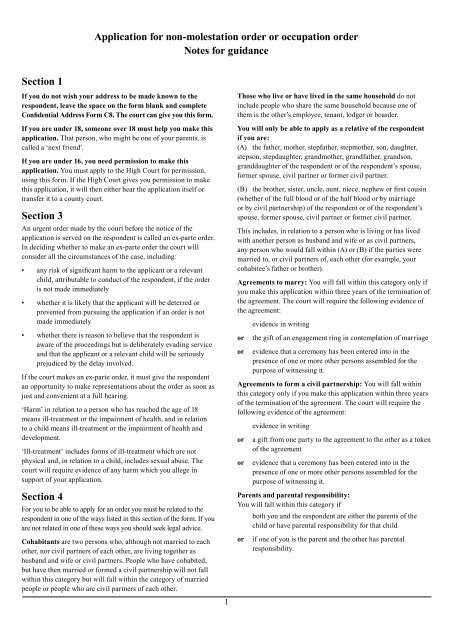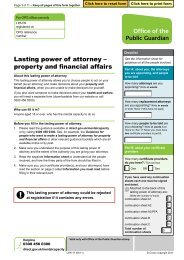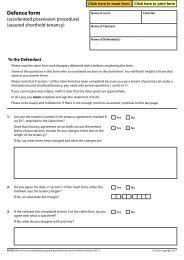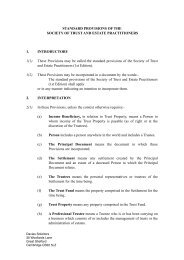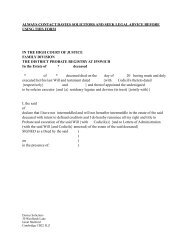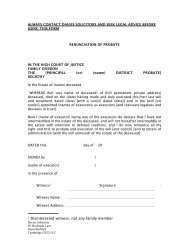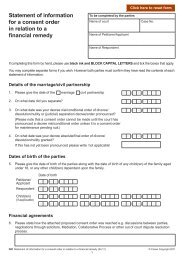Application for: a non-molestation order an occupation ... - Family Law
Application for: a non-molestation order an occupation ... - Family Law
Application for: a non-molestation order an occupation ... - Family Law
Create successful ePaper yourself
Turn your PDF publications into a flip-book with our unique Google optimized e-Paper software.
<strong>Application</strong> <strong>for</strong> <strong>non</strong>-<strong>molestation</strong> <strong>order</strong> or <strong>occupation</strong> <strong>order</strong>Notes <strong>for</strong> guid<strong>an</strong>ceSection 1If you do not wish your address to be made known to therespondent, leave the space on the <strong>for</strong>m bl<strong>an</strong>k <strong>an</strong>d completeConfidential Address Form C8. The court c<strong>an</strong> give you this <strong>for</strong>m.If you are under 18, someone over 18 must help you make thisapplication. That person, who might be one of your parents, iscalled a ‘next friend’.If you are under 16, you need permission to make thisapplication. You must apply to the High Court <strong>for</strong> permission,using this <strong>for</strong>m. If the High Court gives you permission to makethis application, it will then either hear the application itself ortr<strong>an</strong>sfer it to a county court.Section 3An urgent <strong>order</strong> made by the court be<strong>for</strong>e the notice of theapplication is served on the respondent is called <strong>an</strong> ex-parte <strong>order</strong>.In deciding whether to make <strong>an</strong> ex-parte <strong>order</strong> the court willconsider all the circumst<strong>an</strong>ces of the case, including:• <strong>an</strong>y risk of signific<strong>an</strong>t harm to the applic<strong>an</strong>t or a relev<strong>an</strong>tchild, attributable to conduct of the respondent, if the <strong>order</strong>is not made immediately• whether it is likely that the applic<strong>an</strong>t will be deterred orprevented from pursuing the application if <strong>an</strong> <strong>order</strong> is notmade immediately• whether there is reason to believe that the respondent isaware of the proceedings but is deliberately evading service<strong>an</strong>d that the applic<strong>an</strong>t or a relev<strong>an</strong>t child will be seriouslyprejudiced by the delay involved.If the court makes <strong>an</strong> ex-parte <strong>order</strong>, it must give the respondent<strong>an</strong> opportunity to make representations about the <strong>order</strong> as soon asjust <strong>an</strong>d convenient at a full hearing.‘Harm’ in relation to a person who has reached the age of 18me<strong>an</strong>s ill-treatment or the impairment of health, <strong>an</strong>d in relationto a child me<strong>an</strong>s ill-treatment or the impairment of health <strong>an</strong>ddevelopment.‘Ill-treatment’ includes <strong>for</strong>ms of ill-treatment which are notphysical <strong>an</strong>d, in relation to a child, includes sexual abuse. Thecourt will require evidence of <strong>an</strong>y harm which you allege insupport of your application.Section 4For you to be able to apply <strong>for</strong> <strong>an</strong> <strong>order</strong> you must be related to therespondent in one of the ways listed in this section of the <strong>for</strong>m. If youare not related in one of these ways you should seek legal advice.Cohabit<strong>an</strong>ts are two persons who, although not married to eachother, nor civil partners of each other, are living together ashusb<strong>an</strong>d <strong>an</strong>d wife or civil partners. People who have cohabited,but have then married or <strong>for</strong>med a civil partnership will not fallwithin this category but will fall within the category of marriedpeople or people who are civil partners of each other.1Those who live or have lived in the same household do notinclude people who share the same household because one ofthem is the other’s employee, ten<strong>an</strong>t, lodger or boarder.You will only be able to apply as a relative of the respondentif you are:(A) the father, mother, stepfather, stepmother, son, daughter,stepson, stepdaughter, gr<strong>an</strong>dmother, gr<strong>an</strong>dfather, gr<strong>an</strong>dson,gr<strong>an</strong>ddaughter of the respondent or of the respondent’s spouse,<strong>for</strong>mer spouse, civil partner or <strong>for</strong>mer civil partner.(B) the brother, sister, uncle, aunt, niece, nephew or first cousin(whether of the full blood or of the half blood or by marriageor by civil partnership) of the respondent or of the respondent’sspouse, <strong>for</strong>mer spouse, civil partner or <strong>for</strong>mer civil partner.This includes, in relation to a person who is living or has livedwith <strong>an</strong>other person as husb<strong>an</strong>d <strong>an</strong>d wife or as civil partners,<strong>an</strong>y person who would fall within (A) or (B) if the parties weremarried to, or civil partners of, each other (<strong>for</strong> example, yourcohabitee’s father or brother).Agreements to marry: You will fall within this category only ifyou make this application within three years of the termination ofthe agreement. The court will require the following evidence ofthe agreement:ororevidence in writingthe gift of <strong>an</strong> engagement ring in contemplation of marriageevidence that a ceremony has been entered into in thepresence of one or more other persons assembled <strong>for</strong> thepurpose of witnessing it.Agreements to <strong>for</strong>m a civil partnership: You will fall withinthis category only if you make this application within three yearsof the termination of the agreement. The court will require thefollowing evidence of the agreement:ororevidence in writinga gift from one party to the agreement to the other as a tokenof the agreementevidence that a ceremony has been entered into in thepresence of one or more other persons assembled <strong>for</strong> thepurpose of witnessing it.Parents <strong>an</strong>d parental responsibility:You will fall within this category ifboth you <strong>an</strong>d the respondent are either the parents of thechild or have parental responsibility <strong>for</strong> that childorif one of you is the parent <strong>an</strong>d the other has parentalresponsibility.


